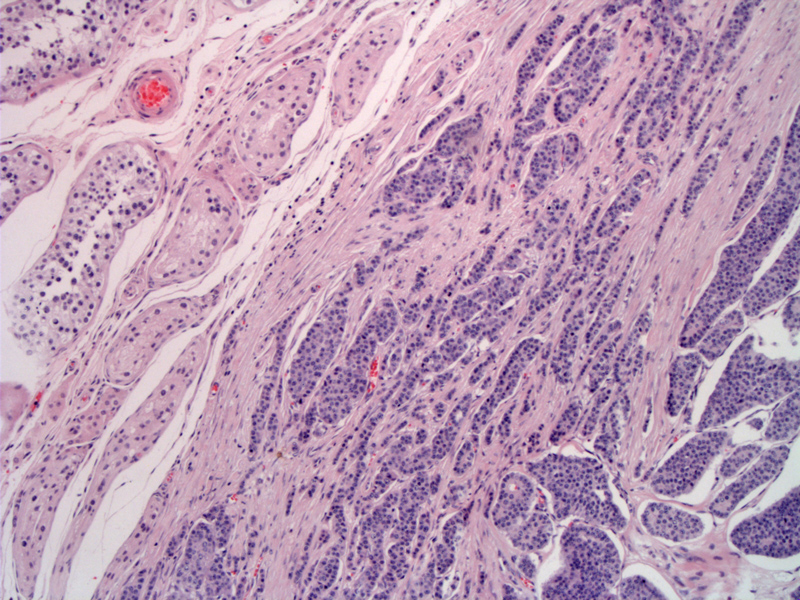

The tumor-normal interface shows a well defined but nonencapulated border. Normal seminiferous tubules are seen on the left.
Microscopically, features typical of carcinoid tumors are seen, with nests and cords of uniform cells with round nuclei. Look for "salt and pepper" chromatin pattern with a fairly inconspicuous nucleoli. Mitotic activity should be minimal, and if prominent and accompanied by atypia and comedonecrosis, a diagnosis of intermediate-grade or moderately differentiated neuroendocrine carcinoma should be entertained (Reyes).
Carcinoid tumors (low grade or well differentiated neuroendocarcinomas) are most commonly found in the GI tract, especially in the ileum and appendix. Other sites where they can arise include lungs, pancreas, biliary tract, thymus and rarely the ovaries and testis (Stroosma). Testicular carcinoid tumors can arise in one of three settings: as a primary, as a metastasis from another location, and within a testicular teratoma.
In a review of 62 cases of testicular carcinoids, Stroosma et al. found 62 cases, 44 of which were primary carcinoids, 6 were metastasis from another primary location and 12 were associated with a testicular teratoma.
Grossly the yellow color may simulate a Leydig cell tumor.
Usually presents as a painless mass. A small minority of patients manifest the carcinoid syndrome with diarrhea, palpitations and hot flashes (Son).
Orchiectomy. Evaluate to exclude other sites as the primary, usually the ileum.
Localized tumors have an excellent prognosis (Stroosma)
Reyes A, et al. Neuroendocrine Carcinomas (Carcinoid Tumor) of the Testis: A Clinicopathologic and Immunohistochemical Study of Ten Cases. Am J Clin Pathol 2003;120:182-7.
Son HY, et al. Primary carcinoid tumor of the bilateral testis associated with carcinoid syndrome. Int J Urol. 2004 Nov;11(11):1041-3.
Stroosma OB, Delaere KP. Carcinoid tumours of the testis. BJU Int. 2008 May;101(9):1101-5.